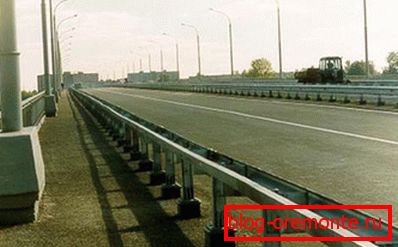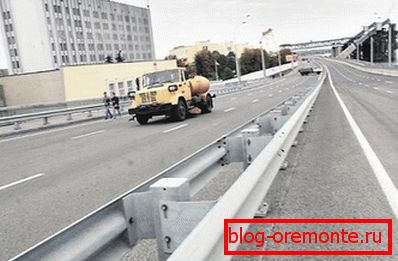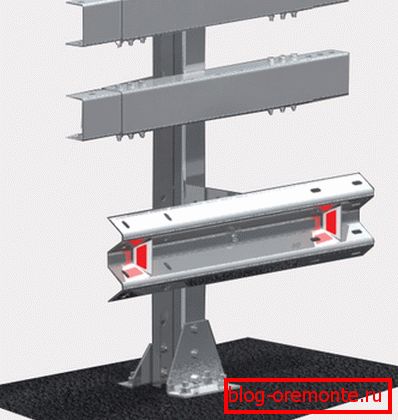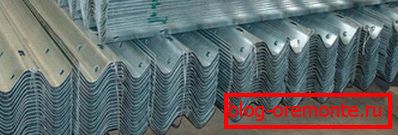Bridge fence: material and options
What could be a bridge fence? What is it made of? What standards does its production follow?
In the article we will try to provide the reader with all the available information about this type of protective structures.

In the photo - bridge fence 11MO.
What it is
The purpose of the manufacture and installation of these structures is simple and clear: they must prevent the congress of cars from the bridge.
They are one of the types of barrier fences, consisting of several fundamentally different designs:
- Reinforced concrete wheel outlets and parapets.
- Plastic barriers filled with sand or water.
Please note: of course, for heavy vehicles, they will constitute more than a symbolic barrier. Plastic barriers are filled mainly in order to prevent their accidental movement.
- Metal fencing barrier type. Actually, a special case of the latter category is the hero of our article.
Manufacturing
Regulations
The product we are talking about is directly related to the safety of life and health of drivers and passengers. That is why their production is standardized. And at the level of not only the general requirements, but also the detailed drawings on which products should be manufactured.
All information is contained in GOST 26804 - 86, adopted nearly thirty years ago.
Let's try to systematize the key points.
- GOST describes the bridge fence of two types. The name of each of them is determined by its purpose: 11MO - one-way barrier barrier type; 11MD - the same, but bilateral, with profile chippers on both sides. It is obvious that the fencing of the second type is intended for the role of separator of oncoming lanes.

Bilateral fence is installed as a separator of oncoming lanes.
- Both types of fencing are mounted using bolted joints and elongated slots for them. Thus, the problem of thermal expansion is solved: the structural elements can move freely relative to each other. In addition, the barriers can be assembled with their own hands by any road worker without the use of special equipment and complex tools.
Curiously: even the racks are attached to the bolts to embedded parts in the bridge construction. The mounting method is chosen for the possibility of easy and quick replacement of elements.
- The distance between racks for bridge fences should be within the range of 1-4 meters. The exact step depends on how often the embedded parts are provided in the bridge construction.
- The beam (the same element that prevents the vehicle from leaving the fencing line) is connected to the strut with a shock-absorbing console. In a collision at a tangent, its deformation will reduce damage to the car and, most importantly, help keep the driver alive.
- The fence is completed with light reflectors (more often they are called reflectors). What is the reason for the instruction? I think it’s clear: in the dark, the line of the fence will be clearly visible in the headlights.

Reflectors make fencing noticeable at night.
- Regulated mass per meter design: 25 kilograms for one-sided fencing and 41 - for two-sided. (see also article)
Technical requirements
Again: it is about the life and health of people. It is possible to treat the Soviet period of the country's history differently, but one thing is undeniable: security-related requirements were extremely stringent, and their violation was punished very severely.
The standards that must be adhered to in the manufacture of barrier bridge fencing, we find in the same GOST; installation requirements are in SNiP 2.05.02-85 and SNiP 2.05.03-84.
- Beams are made only and exclusively from steel bent section with dimensions of 312x83x4 millimeters produced according to technical conditions TU 14-2-341-78. For the manufacture can be used steel grades VSt3kp and VSt3ps, corresponding to GOST 380-71.
- Mutual displacement of beams should not exceed 10 millimeters. However, the text of the standard immediately specifies that in the area of the expansion joint of the bridge, individual design solutions are provided to compensate for the maximum possible relative displacement of fencing elements.
- Racks of all bridge fences are made only and exclusively of I-beam № 12 according to GOST 8239-72. Flanges (flat pads that are attached to mortgages) are made of 20 mm GOST 14637-79 steel, while the use of steels VSt3ps, VSt3sp according to GOST 380-71 is acceptable.

I-beam provides the rack with the ability to withstand large horizontal loads.
- Consoles - shock absorbers, designed to extinguish the inertia of the car in a collision with a beam, are made of 4 mm sheet steel GOST 19903-74. Used steel brand VSt3 (GOST 380-71).
- The beams are attached to the consoles with bolts M16x45. Bolts with a semicircular head and a square head restraint, produced again according to the standard number 7802-81, should be used.
- Mortgage bolts M20x70 bolts (standard 7798-70).
- All structural elements must have anti-corrosion protection. The reason is clear: rust will reduce the strength of the fence, and the appearance will noticeably suffer. The method of protection is not regulated: it can be a zinc layer or a paint and varnish coating.

Of course, zinc provides more long-term protection.
- The deviation of the section from a straight line should not exceed 3 millimeters per linear meter.
The price per meter of fencing for wholesale supply by the manufacturer ranges from one to four thousand rubles depending on the type (one-sided or two-sided), type of anti-corrosion protection (zinc coating is more expensive than paint) and pitch racks.
Conclusion
As you can see, the manufacture of products to which we paid attention, is regulated extremely rigidly. Standards pay attention to the smallest details. (see also the article Features of parking fences)
As usual, in the presented video in this article you will find additional information on this topic. Successes in construction!